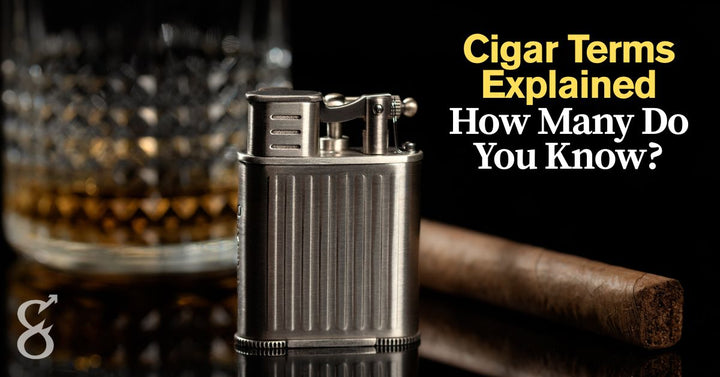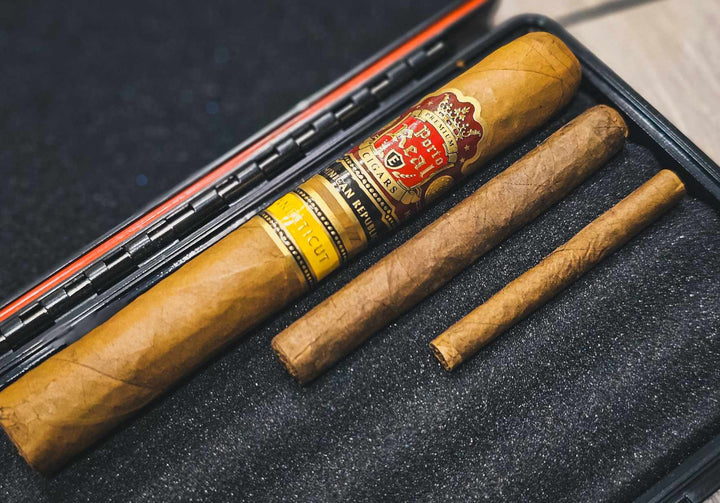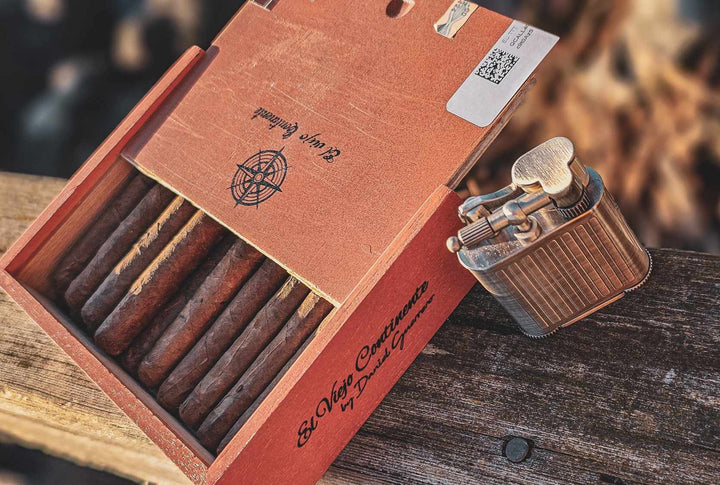Cigar Terms Explained – How many do you know?

Smoking cigars is more than just lighting one up and kicking back. It’s an experience, a ritual, a hobby, and often a conversation filled with words that can be confusing if you are not completely familiar with the terminology and jargon. Whether you are just starting out or have a growing cigar collection, understanding cigar terminology helps you better choose cigars and talk shop with more confidence.
Let’s dive into some of the most common and less known cigar terms, categorized by how likely you are to hear them, and understand them.
Beginner Terms Every Smoker Should Know
If you have just recently cut & smoked your first cigar and are now desparately browsing for soft flame lighters, cigar cutters and new cigars to try out, start here.

Wrapper
This is the outermost tobacco leaf on the cigar. Wrappers affect both flavor and appearance. Common types include Connecticut, Habano, and Maduro.
Filler
The blend of tobacco leaves inside the cigar. These provide the main body of flavor and strength. Fillers often include leaves from multiple countries.
Binder
The leaf that holds the filler together inside the cigar. It plays a key role in burn consistency and overall structure.
Cap
The small rounded piece of tobacco leaf at the head of the cigar. You remove this before smoking using a sharp cutter like a stainless steel cigar cutter.
Foot
The open end of the cigar that you light. A clean cut and proper lighting are key to even burn.
Ring Gauge
This measures the cigar’s thickness in 64ths of an inch. A 64-ring gauge equals 1 inch in diameter. A 25 mm cigar is about a 63 ring gauge.
Draw
How easily air flows through the cigar when you puff. A good draw is smooth but offers slight resistance.
Burn
Refers to how evenly the cigar burns. A straight burn line is a sign of good construction.

Intermediate Terms You Might Hear Quite Often
Once you've smoked a few cigars and are now reading cigar reviews and looking for that perfect ashtray during the evenings, these terms become more common.

Maduro
A dark wrapper that is often aged longer. It adds rich notes like chocolate, coffee, and spice. "Maduro" is Spanish for "mature" and signals the longer fermentation process that gives this wrapper its rich notes.
Retrohale
When you push smoke through your nose instead of your mouth to identify subtle flavors. Used by more seasoned smokers.
Box Pressed
A cigar that’s pressed into a square shape during aging. It changes how the cigar smokes and feels in hand.
Vitola
The size and shape of a cigar. “Toro,” “Robusto,” and “Churchill” are all examples of vitolas.
Cold Draw
When you puff the cigar before lighting it to get an early sense of the flavor profile.
Canoeing
When one side of the cigar burns faster than the other, creating an uneven shape, usually a result of poor lighting or construction.
Tunneling
When the filler burns faster than the wrapper and binder. Can lead to a poor smoking experience and is a sign of bad construction or incorrect humidification.
Advanced Terms
These are the cigar terms that don’t come up in every conversation but are fun to know and can elevate your appreciation of our favorite hobby even more.

Torcedor
A highly skilled cigar roller, often working in traditional factories. True Torcedores can roll thousands of cigars a week with consistency.
Fuma
A cigar made from left-over tobacco from long-filler, premium cigars. Rollers made these of scraps to take home and smoke.
Culebra
A rare style made of three thin cigars braided together. Often unraveled and smoked separately.
Ligero, Viso, Seco, Volado
Types of filler leaves.
-
Ligero gives strength and boldness
-
Viso adds balanced flavors
-
Seco adds aroma
-
Volado ensures a good burn
Plume
A fine, white crystal-like bloom that forms on aged cigars. It’s not mold, it’s the result of natural oils surfacing and a sign of proper aging. Difference between this and mold is that plume comes off easily, while mold often stains the wrapper and is colored and fuzzy.
Toothy Wrapper
A cigar wrapper with visible oil bumps or "teeth" — often from sun-grown leaves. It indicates a rich, flavorful wrapper.
Rosado
A reddish-hued wrapper leaf prized for its balance between strength and smoothness. Often seen in premium, boutique blends.
How many did you already know before? If you already knew over 90% of these, you are a true a cigar smoking veteran already!
Why Learning These Terms Helps You Choose Better
Understanding cigar terminology doesn’t just make you sound smart. It helps you make better choices.
When someone describes a cigar as “box pressed with a maduro wrapper and ligero filler,” you’ll know what they mean, and whether it’s your kind of smoke or not.
It also helps when buying accessories. For example, if your cigar has a thick ring gauge, you might prefer a wide cutter or a pocket torch lighter with a strong flame to get it started properly.
Cigar Terms FAQ
What is a cigar cap and how do you cut it?
The cap is the small circular piece at the top of the cigar. Use a cutter to remove just enough for a clean draw, without damaging the wrapper.
What does it mean when a cigar is box pressed?
It means the cigar has been shaped into a square during aging. This can affect burn and how it feels in the mouth and hand.
How do I fix canoeing while smoking?
Relight the slower-burning side or touch it up with a jet lighter flame. Proper initial lighting helps avoid this altogether.
If you’re getting deeper into the world of cigars, don’t hesitate to explore our blog for more guides or take a look at our cigar accessories collection to enhance your smoking experience.




